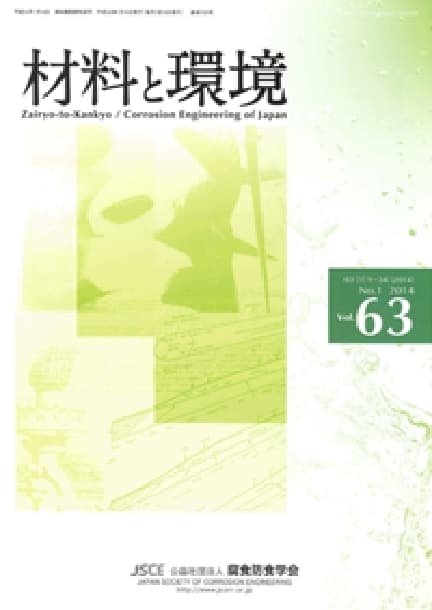- TOP
- Zairyo-to-Kankyo
- Vol. 61 (2012), No. 9
Zairyo-to-Kankyo Vol. 61 (2012), No. 9
Backnumber
-
Vol. 74 (2025)
-
Vol. 73 (2024)
-
Vol. 72 (2023)
-
Vol. 71 (2022)
-
Vol. 70 (2021)
-
Vol. 69 (2020)
-
Vol. 68 (2019)
-
Vol. 67 (2018)
-
Vol. 66 (2017)
-
Vol. 65 (2016)
-
Vol. 64 (2015)
-
Vol. 63 (2014)
-
Vol. 62 (2013)
-
Vol. 61 (2012)
-
Vol. 60 (2011)
-
Vol. 59 (2010)
-
Vol. 58 (2009)
-
Vol. 57 (2008)
-
Vol. 56 (2007)
-
Vol. 55 (2006)
-
Vol. 54 (2005)
-
Vol. 53 (2004)
-
Vol. 52 (2003)
-
Vol. 51 (2002)
-
Vol. 50 (2001)
-
Vol. 49 (2000)
-
Vol. 48 (1999)
-
Vol. 47 (1998)
-
Vol. 46 (1997)
-
Vol. 45 (1996)
-
Vol. 44 (1995)
-
Vol. 43 (1994)
-
Vol. 42 (1993)
-
Vol. 41 (1992)
-
Vol. 40 (1991)
Keyword Ranking
17 Dec. (Last 30 Days)
Zairyo-to-Kankyo Vol. 61 (2012), No. 9
Underpotential Deposition and Metallic Corrosion Reaction
Masahiro Seo
pp. 341-348
DOI:
10.3323/jcorr.61.341Abstract
Electrodeposition of metal ions, Mz+, on foreign metal substrate, M', at potentials more positive than the reversible potential of the Mz+/M electrode is termed “underpotential deposition (UPD)”. The general feature of UPD was described, laying emphasis on the width of UPD potential window being to proportional to the difference in work function between two metals, M' and M. The effects of UPD on electrode reactions such as oxygen reduction, hydrogen evolution and metallic corrosion were reviewed and the discussion was made on the roles of UPD in the mechanism of electrode reactions. Particularly, the effect of Pb-UPD on corrosion of Ni was explained in detail with relation to the Pb-induced stress corrosion cracking (Pb-SCC) of Ni base alloys. Moreover, the structural change from UPD adsorption layer to surface alloy and the co-adsorption structure of electrolyte anions and of UPD metal atoms were exemplified and the importance of in-situ analysis of the electrode interface was pointed out to clarify the roles of UPD in reaction mechanism.
Electrochemical Characteristics of Alloy 182 Weld and Low Alloy Steel in High Temperature and High Pressure Water from 25°C to 288°C
Jun'ichi Sakai
pp. 356-358
DOI:
10.3323/jcorr.61.356Abstract
This study was carried out to clarify the electrochemical characteristics of Alloy 182 Weld and Low Alloy Steel in high temperature and high pressure water from 25°C to 288°C. The specimen was obtained from Alloy 182 overlaid weld and low alloy steel. Corrosion potential of each metals and galvanic current between the metals in 5.0×10−3 M H2SO4 and 4.5×10−3 M Na2SO4 aqueous solution were measured in an autoclave. The temperature of the autoclave was raised from 25°C to 288°C at a rate of 5°C/min. As the results of these tests, temperature range was observed in which alloy 182 has possibility to dissolve, i.e., corrosion potential of Alloy 182 was less noble than low alloy steel between 170°C and 220°C.
Improvement of Corrosion Resistance in Austenitic Stainless Steel by Grain Boundary Character Distribution Control
Yun Wang, Junya Kaneda, Shigeki Kasahara, Naoto Shigenaka
pp. 359-365
DOI:
10.3323/jcorr.61.359Abstract
Strauss test, Coriou test and Huey test were conducted on a Type 316L austenitic stainless steel. Improvement in grain boundary corrosion resistance was verified after raising low Σ coincidence site lattice (CSL) grain boundary (GB) frequency by controlling grain boundary character distribution (GBCD). During crevice corrosion test under gamma-ray irradiation, initiation frequency of GB corrosion after GBCD controlled specimens decreased to 1/10 of GBCD uncontrolled counterpart along with lower depth of corrosion. Stress corrosion cracking (SCC) propagation rate of GBCD controlled specimen decreased to less than 1/2 of GBCD uncontrolled specimen in high temperature and high pressure water. Based on these results, we expect that GBCD control will improve corrosion resistance of austenitic material in a wide range of application and environment.
Article Access Ranking
17 Dec. (Last 30 Days)
-
Delayed Fracture Mechanism of 1700 MPa-Class Quenched and Tempered Bolt under Atmospheric Corrosion Environment
Tetsu-to-Hagané Advance Publication
-
Perspectives on the Promising Pathways to Zero Carbon Emissions in the Steel Industry toward 2050
ISIJ International Vol.65(2025), No.2
-
Effect of B on Surface Oxidation Behavior and Phosphatability of Si-Mn-added Cold-Rolled Steel Sheets
ISIJ International Advance Publication
-
Factors Influencing the Bonding Phase Structure of Iron Ore Sinters
ISIJ International Vol.43(2003), No.9
-
Effect of microstructural heterogeneity on fatigue limit of as-quenched low-carbon low-alloy martensitic steel
ISIJ International Advance Publication
-
Prussian blue as a fully reversible hydrogenochromic material for visualizing hydrogen distribution in Fe sheet
ISIJ International Advance Publication
-
Metallurgical Aspects on Interstitial Free Sheet Steel From Industrial Viewpoints
ISIJ International Vol.34(1994), No.1
-
Microstructures and Reduction Properties of High CaO Concentration Sintered Ore
ISIJ International Advance Publication
-
Influence of Antimony on the Oxidation Characteristics of 65Mn Steel
ISIJ International Advance Publication
-
From plasticity to fracture in pearlitic microstructures: Atomistic study of cementite thickness and deformation localization
ISIJ International Advance Publication
You can use this feature after you logged into the site.
Please click the button below.










